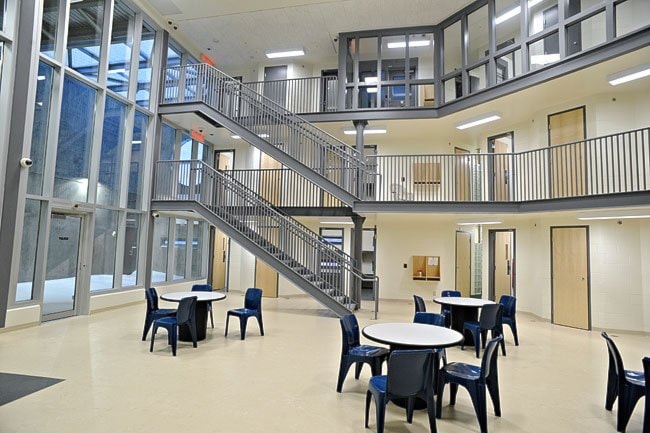When inmates are transferred to the new Whitehorse Correctional Centre next month, the biggest change for most prisoners is that each will have their own room, rather than having to occupy a crowded dormitory.
Doors are made of solid birch and feature small windows, rather than being metal and barred.
Toilets and sinks are porcelain, rather than, in some cases in the old jail, stainless steel.
And most rooms include a feature that’s sure to infuriate some tough-on-crime critics: a 17-inch flat-screen television, hooked up to eight satellite channels.
But Bob Riches, the Yukon’s assistant deputy minister of corrections, says experience at Prince George’s jail, where he once worked, shows a little television goes a long way to cool tempers in prison.
“Within a period of weeks, the temperature just dropped,” he said. “I think you’re more likely to change in a place that’s less oppressive.”
Riches has spent nearly three decades working in 13 prisons, serving as the warden in six. “I’ve worked in some pretty rotten old joints in my life,” he said.
And from his experience, if the goal is to rehabilitate prisoners then “harsh punishment doesn’t work.”
Whether the new prison lives up to his aspirations remains to be seen. It’s a persistent gripe among inmates that little programming is available to allow them to work through their anger and trauma.
Currently, two correctional officers focus on programming. In the new jail, one more will be added to their ranks.
Riches envisions most correctional officers will spend less time enforcing rules and more time counselling inmates under a scheme called “integrated offender management.”
Inmates may choose to go back to their cell to watch television, rather than work on their case plans. But if they do they won’t be eligible for early release, he said.
[image2]
“You can’t force anybody to sit in a classroom. But if they don’t, there’s a consequence for that.”
Riches also hopes to see more prisoners take jobs cooking, cleaning and doing laundry at the new facility.
Inmates will reside in cell blocks comprised of 14 to 21 rooms, stacked over two or three storeys. Cells open to a spacious common room with windows that reach up to a high ceiling, allowing natural light to filter in. Beyond the windows is a new kind of fine-meshed, inward-curving chain-link fence, said to be unclimbable.
Inmates will socialize and eat their meals there at round, plastic tables, weighted with sand to prevent them from being easily thrown. There’s a phone for inmates with a calling card and a room set aside for programming.
Each cell block also includes its own yard. It’s small - about 50 square metres - and will feature a basketball hoop and a set of weights.
There’s a reason why inmates won’t be gathered in large groups in exercise yards and dining halls. That’s usually how violent outbreaks occur, said Riches, who has suffered a broken hand and punched kidney in crowded dining halls.
“It’s best for us to keep people separate - the more separate, the better.”
Each common area has a desk for a guard. But correctional officers will be expected to mingle and chat with inmates in the hall, said Riches.
“It’s not like the old days when inmates were on one side of the bars and guards were on the other.”
Overlooking each common room is a row of second-storey one-way mirrors, allowing staff at a central surveillance post to peer into every cellblock.
There are also 408 closed-circuit surveillance cameras scattered around the prison, watched on an array of monitors by staff.
But no cells have cameras, other than those in segregation, where inmates may be on suicide watch.
There’s also one wheelchair-accessible cell. And both the male and female segregation units have special cells, kept under negative air pressure to prevent sick inmates from spreading airborne illnesses.
Correctional officers have their own fitness room and will be able to do a 45-minute workout at work to ensure they stay fit. That’s important in a three-storey facility in which they may have to run quickly up and down stairs.
Inmates have a multi-purpose room for special gatherings. There’s a “healing room” for First Nation cultural events, designed in the shape of a crocus flower, with exposed wooden beams and a big skylight.
And the new kitchen includes a room for the preparation of wild game to satisfy food safety rules. “It’s not as simple as people think,” said Riches. “You can’t just bring a moose in here and cut it up.”
At 7,000 square metres, the new prison is nearly double the size of the old one. It’s expected to have a life of 40 years and is able to hold upwards of 190 inmates, when all rooms are double-bunked. The old prison has been retrofitted to hold 120, and is currently occupied by 107.
The new building is heated with wood chips, with a propane boiler backup.
It cost $70.3 million to build. That’s $4.1 million above the initial price tag of $66.26 million, but within the usual variance of 10 per cent typically assumed for big public works projects.
The government hasn’t yet made plans to demolish the old prison. The standalone women’s facility will be transferred to the Department of Health and Social Services in April. Its plans for the facility aren’t yet clear.
Contact John Thompson at
johnt@yukon-news.com
